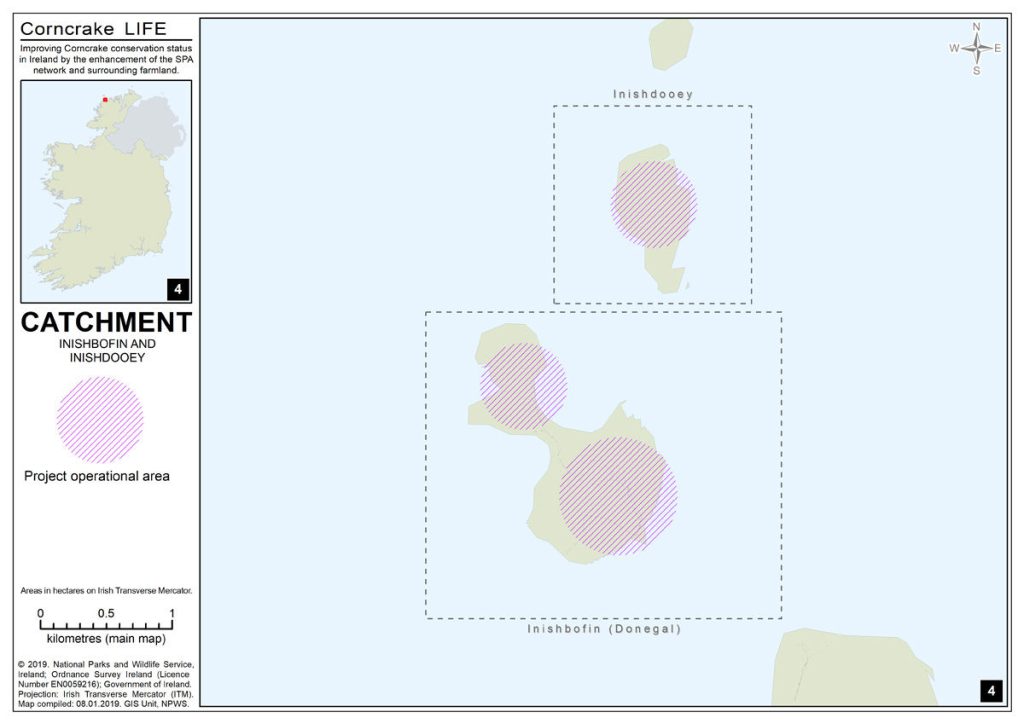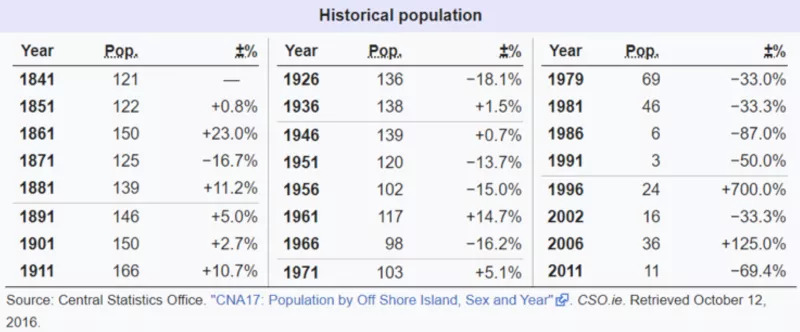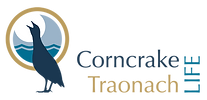Wildlife
Inishbofin, Inishdooey and Inishbeg SPA supports a nationally important wintering population of Barnacle Goose (322 individuals – 4 survey mean between 1993 and 2003). The birds use the islands for both feeding and roosting but at times also commute to other sites in the region. The site also supports a breeding population of Corncrake (13 pairs – five year mean peak between 2003 and 2007, based on records of calling males). Inishbofin, Inishdooey and Inishbeg SPA is one of a suite of sites along the western seaboard that is regularly utilised by nationally important numbers of breeding Corncrake.
Inishbofin / Inis Bó Finne (“Island of the White Cow”), is situated 3km / 2miles (ten minutes by boat) from the pier at Machaire Uí Rabhartaigh / Magheroarty / Gortahork, from which a regular ferry service has run since 2004.

Inishbofin / Inis Bó Finne (“Island of the White Cow”), is situated 3km / 2miles (ten minutes by boat) from the pier at Machaire Uí Rabhartaigh / Magheroarty / Gortahork, from which a regular ferry service has run since 2004.
The island covers 120-hectares (300 acres), with an economy traditionally based on fishing and farming. Irish is spoken routinely. There are no pubs or shops on the island. There is a boat service to and from it but no regular ferry.
Covering 300 acres, this island has two halves connected by a narrow, sandy col. The southern half of the island is fertile and was cultivated in the past in the traditional ‘clachan and rundale’ manner, involving communal usage of scarce arable soil and cattle pasture. The ancient field boundaries are still in place, though the fields have now reverted to grassland, providing essential habitat for geese and especially Corncrakes – flourishing here.

There are two former villages on the island, one near the harbour of An Clachan, and the other a short distance away at An Garradh Bán.
The first inhabitants are believed to have been of Scandinavian origin, who arrived at the time of the Viking raids on Ireland’s coast in the C9th and C10th. Their descendants are thought to have been exterminated by Cromwellian soldiers in the mid-C17th. Subsequently the island was settled by mainlanders from Donegal escaping oppression, poverty and famine. It is said that the islands potatoes were unaffected by the blight which destroyed the main food source of Ireland’s peasantry, leading to the illnesses, deaths and mass emigration caused by the mid-19th Great Famine.
Demographics
Inishbofin’s population dropped in 100 years from 166 (1911) to 11 (2011).
Inishbofin has witnessed a number of maritime tragedies. In 1929 an island fishing boat was cut in half by a larger boat in thick fog, and all but one man drowned. In 1940 a ship by the name of Stulwik crashed into rocks and 10 people perished.

As recently as the 1960s, a population of roughly 120 islanders enjoyed a tranquil, if tough, existence, fishing and farming. Nowadays, only a few hardy souls spend all year on the island, farming on a part-time basis.
However from March to October many of the former inhabitants return to fish for lobster, crab and Atlantic salmon, or to gather shellfish and pick edible seaweeds such as cairrigin (carrageen) and creathnach (dulse) from the rocks. Other families move back for the duration of the summer school holidays. Many of the houses on the island have been renovated, mostly for use as holiday homes.
Until recently, there were no visitors’ facilities of any kind on the island. The summer of 2002 saw the arrival of electricity and running water, and the opening of a 30-bed hostel at An Clachan. Most visitors come to spot birds and / or explore strange rock formations around the coastline.
The islanders enjoy speaking to visitors (preferably in Irish Gaelic) and like telling stories about the island and its history. Linguists have commented on their unusual speech patterns, involving “echo” repetition, said to have been typical of story-telling communities.
Inishbofin has witnessed a number of maritime tragedies. In 1929 an island fishing boat was cut in half by a larger boat in thick fog, and all but one man drowned. In 1940 a ship by the name of Stulwik crashed into rocks and 10 people perished.
As recently as the 1960s, a population of roughly 120 islanders enjoyed a tranquil, if tough, existence, fishing and farming. Nowadays, only a few hardy souls spend all year on the island, farming on a part-time basis.
However from March to October many of the former inhabitants return to fish for lobster, crab and Atlantic salmon, or to gather shellfish and pick edible seaweeds such as cairrigin (carrageen) and creathnach (dulse) from the rocks. Other families move back for the duration of the summer school holidays. Many of the houses on the island have been renovated, mostly for use as holiday homes.
Until recently, there were no visitors’ facilities of any kind on the island. The summer of 2002 saw the arrival of electricity and running water, and the opening of a 30-bed hostel at An Clachan. Most visitors come to spot birds and / or explore strange rock formations around the coastline.
The islanders enjoy speaking to visitors (preferably in Irish Gaelic) and like telling stories about the island and its history. Linguists have commented on their unusual speech patterns, involving “echo” repetition, said to have been typical of story-telling communities.
Inishdooey / Inis Dhubhnach is a small uninhabited island, especially noted for the magnificent arches and caves on its eastern side. The island is named after, and features the ruins of a church supposedly founded by, the legendary 6th-century Saint Dubhthach / Dooey. The remains of stone enclosures built with great effort over many years are also visible.
Inishbofin, Inishdooey and Inishbeg SPA consists of three small to medium-sized islands located between 1 km and 4 km off the north-west coast of Co. Donegal. The site is a Special Protection Area (SPA) under the E.U. Birds Directive, of special conservation interest for the following species: Barnacle Goose, Corncrake, Common Gull, Lesser Black-backed Gull and Arctic Tern.
For more Maps and Tourist Information visit: https://www.govisitdonegal.com
